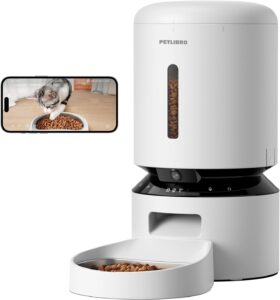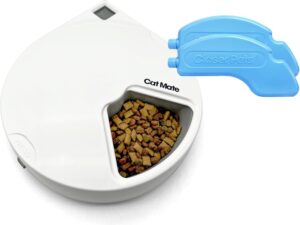Ever rushed home because you forgot to feed your cat? Or woken up at 5 AM to demanding meows? I’ve been there. After years of dealing with my food-obsessed tabby, I discovered smart cat feeders—and honestly, they changed my life.
Let me walk you through the best options I’ve tested and why they’re worth every penny.
Quick Pick: Our #1 Recommendation
PETLIBRO Automatic Cat Feeder with Camera – 5L capacity with 1080P HD video
This is my top pick hands down. You get app control, a built-in camera with night vision, and two-way audio so you can actually talk to your cat at mealtime. The 5-liter hopper means fewer refills, and the motion detection alerts you when your cat approaches. It’s the complete package for tech-savvy cat parents who want total control.
1. PETLIBRO Automatic Cat Feeder with Camera

Best For: Cat parents who want to monitor feeding remotely
I love watching my cat eat through the camera. Sounds weird, I know. But when you’re away for the weekend, seeing your furry friend chow down gives you serious peace of mind.
The 1080P camera delivers crystal-clear video, even at night. The two-way audio means I can call my cat to dinner when she’s napping elsewhere. The app lets you schedule up to 10 meals daily with customizable portions. You control everything from your phone—portion sizes, feeding times, meal calls.
Specs:
- 5-liter capacity (holds about 21 cups of dry food)
- 1080P HD camera with 145-degree wide-angle lens and night vision
- Supports both 2.4G and 5G WiFi
Pros:
- Crystal-clear video monitoring day and night
- Two-way audio to interact with your cat
- Smart notifications for low food, blockages, and motion detection
1. PETLIBRO Automatic Cat Feeder with Camera

Best For: Cat parents who want to monitor feeding remotely
I love watching my cat eat through the camera. Sounds weird, I know. But when you’re away for the weekend, seeing your furry friend chow down gives you serious peace of mind.
The 1080P camera delivers crystal-clear video, even at night. The two-way audio means I can call my cat to dinner when she’s napping elsewhere. The app lets you schedule up to 10 meals daily with customizable portions. You control everything from your phone—portion sizes, feeding times, meal calls.
Specs:
- 5-liter capacity (holds about 21 cups of dry food)
- 1080P HD camera with 145-degree wide-angle lens and night vision
- Supports both 2.4G and 5G WiFi
Pros:
- Crystal-clear video monitoring day and night
- Two-way audio to interact with your cat
- Smart notifications for low food, blockages, and motion detection
2. Cat Mate C500 Automatic Pet Feeder

Best For: Budget-conscious cat owners who feed wet food
This feeder is a lifesaver for wet food. Most automatic feeders only handle dry kibble. The C500 handles both with ease thanks to its ice pack system.
The rotating carousel holds five separate meals. Each compartment fits up to 3/4 pound of food. The twin ice packs keep wet food fresh for hours. I’ve used this for weekend trips, and the food was still fresh when I got home. No app, no WiFi—just simple digital programming that actually works.
Specs:
- Five meal compartments (3/4 lb each)
- Twin ice packs for freshness
- Digital timer with up to 4 programmable mealtimes
Pros:
- Works with wet AND dry food
- Ice packs keep food fresh without electricity
- Pet-proof design prevents sneaky paw access
3. PetSafe Smart Feed Automatic Feeder

Best For: Multi-cat households wanting Alexa integration
“Alexa, feed the cats.” That’s all I have to say now. The PetSafe Smart Feed works with Amazon Echo, making feeding ridiculously convenient.
The 24-cup hopper is massive. I refill it maybe once every two weeks. The app lets you schedule 12 daily meals with portions from 1/8 to 4 cups. The slow-feed mode dispenses food gradually over 15 minutes—perfect for my cat who used to inhale her food and throw it up. The low-food sensor alerts your phone before you run out.
Specs:
- 24-cup capacity hopper
- WiFi-enabled with My PetSafe app control
- Alexa and Amazon Dash Replenishment compatible
Pros:
- Huge capacity means less frequent refilling
- Alexa voice control for hands-free feeding
- Slow-feed mode prevents fast eating and vomiting
4. PETLIBRO Granary Automatic Cat Feeder

Best For: Cat owners wanting app control without a camera
Not everyone needs a camera. This PETLIBRO model gives you all the smart features minus the video monitoring—and saves you money.
The 5-liter capacity handles about three weeks of food for one cat. The app supports both 2.4G and 5G WiFi (many feeders only do 2.4G). You can schedule up to 10 meals daily with precision portion control. The desiccant bag and airtight seal keep food fresh longer. I appreciate the low-food sensor that notifies my phone before it runs empty.
Specs:
- 5-liter food hopper
- Dual-band WiFi (2.4G and 5G)
- Up to 10 meals per day, 1-48 portions per meal
Pros:
- Supports both 2.4G and 5G WiFi networks
- Airtight freshness system with desiccant bag
- More affordable than camera models
What to Consider When Buying a Smart Cat Feeder
Capacity and Refill Frequency
Bigger isn’t always better. Think about how often you’re comfortable refilling.
A 2-liter feeder works fine for one cat with daily refills. A 5-liter hopper handles one cat for weeks or multiple cats for days. I prefer larger capacity—fewer refills mean less hassle. But if you’re picky about food freshness, smaller hoppers ensure faster turnover.
App Features and Connectivity
Not all apps are created equal. Some are intuitive. Others make you want to throw your phone.
Look for feeders with reliable WiFi connectivity. Check if it supports both 2.4G and 5G networks. Most only support 2.4G, which can be limiting. The app should let you schedule multiple meals, adjust portions, and view feeding logs. Bonus points for push notifications when food runs low or jams occur.
Power Source Options
Power outages happen. Your cat still needs to eat.
Battery backup is non-negotiable for me. Some feeders use D-cell batteries, others have rechargeable lithium batteries. Dual-power systems (AC adapter + battery backup) offer the best reliability. I learned this the hard way when a storm knocked out power for two days. My battery-backed feeder kept working. My neighbor’s didn’t.
Camera and Monitoring
Do you really need to watch your cat eat? Maybe not. But it’s incredibly reassuring.
Cameras add cost but provide peace of mind. Look for 1080P HD quality minimum. Night vision matters if your cat eats in the dark. Two-way audio lets you call your cat or just hear what’s happening. Motion detection alerts are handy for monitoring activity patterns.
Food Type Compatibility
Most feeders work with dry kibble only. Size matters here.
Check the kibble size range—usually 2-15mm diameter. Smaller kibbles flow better. Larger pieces can jam. If you feed wet food, your options shrink dramatically. The Cat Mate C500 is one of the few that handles wet food reliably with its ice pack system.
Portion Control Accuracy
Consistency matters for weight management. I’ve seen feeders that wildly vary portion sizes.
Quality feeders dispense accurate amounts every time. Look for models that let you adjust portions in small increments. My PETLIBRO dispenses in 1/12 cup increments—perfect for fine-tuning meals. Cheaper feeders might only offer preset amounts that don’t match your needs.
Feeding Schedule Flexibility
How many times does your cat eat daily? Can you adjust on the fly?
Basic feeders offer 2-4 meals daily. Smart feeders typically allow 6-12 scheduled meals. Some cats need frequent small meals for medical reasons. Others do fine with twice-daily feeding. Remote feeding buttons are clutch for treating your cat or adjusting the schedule unexpectedly.
Freshness Features
Stale food is gross. Cats agree.
Desiccant bags absorb moisture and keep kibble crunchy. Airtight seals prevent air exposure. Some feeders have patented rotor systems that seal the food outlet between dispensing. For wet food, ice packs are essential. Without freshness features, food can spoil or lose appeal.
Build Quality and Durability
Cheap plastics crack. Flimsy parts break. Your cat suffers.
I’ve replaced feeders that literally fell apart after months. Now I check for BPA-free materials and reinforced stitching. Dishwasher-safe components make cleaning easier. Stainless steel bowls resist bacteria better than plastic. The feeder should feel solid, not hollow and cheap.
Tamper-Proof Design
Cats are sneaky. Smart ones will figure out how to break into feeders.
Look for locking lids and secure dispensing mechanisms. My friend’s cat learned to tip his feeder to get extra food. A weighted base or wall-mounting option prevents this. The food outlet should be too small for paws to reach inside.
Noise Level
Some feeders sound like tiny helicopters. Others are whisper-quiet.
Motor noise varies wildly between models. If your cat is skittish, loud dispensing sounds might scare them away from meals. Read reviews specifically mentioning noise. I returned one feeder because the grinding sound freaked out my nervous rescue cat.
Multi-Pet Features
Two cats means twice the complexity. Some feeders handle this better than others.
Meal splitters divide food between two bowls. RFID collar-tag feeders ensure each cat gets their own food—perfect for special diets. Without these features, one cat usually steals the other’s food. I’ve seen this drama play out countless times.
Final Thoughts
Here’s what I’ve learned: A smart cat feeder isn’t a luxury—it’s a sanity saver. Since getting mine, I sleep through the night. My cat doesn’t beg constantly. Her weight is finally under control.
My top recommendation? The PETLIBRO Automatic Cat Feeder with Camera. The video monitoring gives me peace of mind when I travel. The app is intuitive. The portions stay consistent. It just works.
But if you feed wet food or want budget-friendly reliability, grab the Cat Mate C500. If you need Alexa integration and massive capacity, go with the PetSafe Smart Feed.
Pick the feeder that matches your lifestyle. Your cat (and your sleep schedule) will thank you.
Frequently Asked Questions
Q: Can automatic feeders dispense wet food?
Very few can. The Cat Mate C500 is your best bet—it uses ice packs to keep wet food fresh in rotating compartments. Most automatic feeders only handle dry kibble because wet food clogs mechanisms and spoils quickly without refrigeration.
Q: What happens if the WiFi goes down?
Your cat still gets fed. Most smart feeders store scheduled feeding times locally. They’ll dispense meals on schedule even without WiFi. You just lose remote control and notifications until connectivity returns. This is why I always set up the schedule in advance.
Q: How long does kibble stay fresh in the feeder?
With proper sealing and desiccant bags, dry food stays fresh for 2-3 weeks. Without these features, moisture and air exposure can make food stale within days. I replace desiccant bags every 2 weeks to maintain freshness. Never fill the hopper with more food than your cat will eat in three weeks.
Q: Can cats break into automatic feeders?
Smart cats definitely try. Quality feeders have locking lids and tamper-proof designs. My friend’s Maine Coon learned to knock over a cheap feeder to spill food. Look for weighted bases and secure locking mechanisms. Some cats are persistent geniuses—read reviews mentioning escape artist cats.
Q: Do I need a camera feature?
Not essential, but incredibly valuable. Cameras let you verify your cat actually ate, check if the feeder malfunctioned, and just see your furry friend when you miss them. I thought cameras were overkill until I used one. Now I can’t imagine going back. It’s worth the extra cost if you travel frequently.
Q: How accurate are portion sizes?
This varies widely by feeder quality. Premium models like PETLIBRO and PetSafe dispense consistent portions within 5% accuracy. Budget feeders can vary by 20-30%, which adds up over time. Inaccurate portions defeat the purpose of portion control. Check reviews mentioning portion consistency before buying.
Q: Can I use an automatic feeder for medication?
For pills mixed with food, yes. For liquid medications or pills that need precise timing, no. The feeder will dispense food on schedule, but you can’t guarantee your cat will eat immediately or consume everything. Talk to your vet about medication timing if you’re considering this.
Q: What size kibble works best?
Most feeders handle kibble between 2-15mm diameter. Smaller kibbles (under 10mm) flow most reliably. Larger pieces can jam the dispensing mechanism. Avoid irregular shapes like triangles or stars—they jam more easily. Round kibbles work best. Check your food bag for kibble dimensions.
Q: How often should I clean the feeder?
Deep clean every 2-3 weeks minimum. Wipe down the bowl daily if possible. Food oils build up and can turn rancid. Most feeders have dishwasher-safe parts, making cleaning easier. I learned the hard way that neglected feeders attract bugs and make food taste bad to cats.
Q: Are smart feeders worth the cost?
Absolutely. My $120 feeder paid for itself in reduced stress and better sleep. Before, I couldn’t sleep past 5 AM without my cat screaming for breakfast. Now she eats on schedule without bothering me. If you value sleep, work long hours, or travel occasionally, smart feeders are 100% worth it. Budget models start around $40—totally affordable for the convenience.
